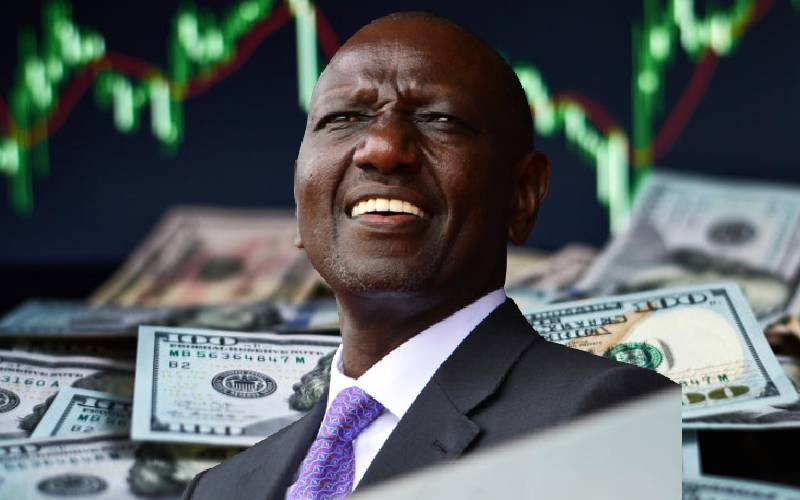
Kenya’s economy is expected to pick up pace and grow by 7.2 per cent by 2028, according to a new development plan by the government. The Kenya Kwanza regime in a plan that plugs into the country’s long-term development blueprint, the Vision 2030, hopes to jumpstart the economy that is grappling with numerous shocks.
In the plan that was launched yesterday by President William Ruto, the Gross Domestic Product – which is the sum of all goods and services produced by the country – will grow to 7.2 per cent from 5.2 per cent in 2022. The measures the government plans to put in place will further create 1.2 million jobs, driven by sectors such as agriculture, housing, healthcare, small and medium enterprises and the digital economy.
The Fourth Medium Term Plan (MTP IV) of Vision 2030, which has been dubbed the Bottom-Up Economic Transformation Agenda for Inclusive Growth, is a five-year plan meant to run between 2023 and 2027. Vision 2030 has since 2008 been implemented in five-year medium-term plans.
“The Fourth Medium Term Plan has translated the strategic objectives set out in our agenda into concrete programmes and projects to be implemented in the period,” said the President.
The BETA medium-term plan will be the final one for Kenya Vision 2030 development blueprint that was launched in 2008 with much optimism that it would transform the country into a middle-income economy.
The National Treasury said that the plan launched yesterday is “the last five-year medium-term plan, which will transition the country to the next long development plan”.
Vision 2030 laid down the journey the country was to take to become a middle-income country by 2030. The measures proposed by the Vision, which was launched during former President Mwai Kibaki’s second term, when President Ruto was agriculture minister, were expected to prop up the economy and see it register an annual growth of 10 per cent by 2012.
Over the fourth medium-term plan, the government said it will put in measures that will propel the economy to the growth of 7.2 per cent. Over the years, the country has been unable to hit many of the targets set out in the medium-term plans including the ambitious double-digit economic growth.
Economic shocks
President Ruto said while there have been major achievements since the country started implementing the Vision 2030, there are still major challenges that have exposed the economy to shocks. He noted the measures that his Kenya Kwanza administration is putting in place would cure some of these challenges.
He noted many of the programmes that will be implemented will aim at uplifting the ‘hustler’.
“Our economy continues to grapple with fundamental challenges, including widening inequality, low productivity, and susceptibility to economic shocks. These challenges demand urgent and resolute interventions to regain lost ground and align ourselves with our aspirations,” he said.
“This is why upon assuming office, our administration pledged to spearhead a radical economic turnaround, fostering inclusive growth and enhancing the livelihoods and welfare of all citizens, particularly those at the bottom of the economic pyramid. These commitments are intricately detailed within the Bottom-Up Economic Transformation Agenda.”
“Consequently, it became imperative to ensure that the MTP IV, together with the County Integrated Development Plans (CIDPs), are aligned with the Bottom Up Economic Transformation Agenda (BETA) objectives and key priorities.”
Ruto’s BETA plan is anchored on five pillars that are agriculture, health care, housing and settlement, micro, small and medium enterprises economy and the digital superhighway and creative economy.
He noted that the government has already started putting measures in place to achieve some of the objectives such as boosting agricultural production through initiatives such as subsidised fertiliser, construction of affordable houses, lending to MSMEs through the Hustler Fund and the implementation of the recently enacted universal healthcare Acts.
“During the Fourth Medium Term Plan, the government will boost production through a value chain approach targeting leather products, textile and apparel, dairy, tea, rice, edible oils, blue economy, minerals, forestry, construction and building materials, among others,” said Ruto.
“Emphasis will be given to the promotion of agro-processing and the strengthening of extension services, provision of quality and affordable farm inputs, cooperative development and management, market access and logistics support, expansion of irrigation infrastructure, adoption of climate-smart agriculture, enhanced agricultural financing, and agricultural mechanisation research and development.”
The plan aims to create 1.2 million jobs. Employment creation has remained an elusive goal for previous administrations, with the economy failing to create adequate jobs to absorb both the unemployed and also the many young people graduating from school. Analysts also note the vast number of jobs created are largely in the informal sector and are usually low-value.
Under the plan, the government said it would increase the share of formal jobs from the current 19 per cent to 40 per cent over the five years. There are about 18 million Kenyans in the job market, out of which only three million are in formal employment.
“To create employment, focus will be given to investment in Special Economic Zones and County Aggregation and Industrial Parks; diversification of export markets and market access of MSMEs goods and services. The Government will also establish Jumuiya cross-border markets and strengthen cooperation with our traditional and new trade partner countries,” said Ruto.